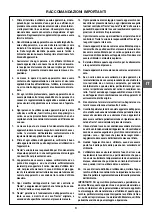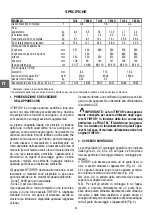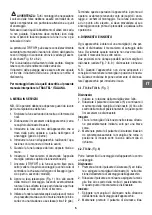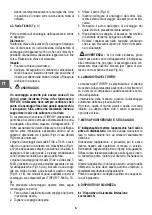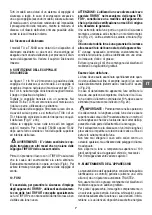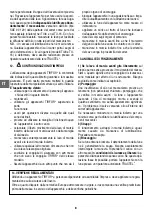
red or the wire rope to be slackened.
8.2. Rope release safety device
Models TU and T-500D are fitted with a «two-handed»
rope release system which requires deliberate operation
by the user to release the machine. See section 4 :
«Releasing and engaging the jaws».
9. REPLACING THE SHEAR PINS
Figures 17,18,19 and 20 show the position of the shear
pins for the various models. Spare shear pins are in the
stub of the operating levers for models TU-8 and TU-16,
and in the rope release lever for the other models,
behind the plastic cap.
Remove the sheared pins with a suitable punch. For
models TU-8 and TU-16, remove the forward operating
handle stub by using an extractor.
Remove the sheared pins. Refit the forward operating
handle stub on the crank and align the grooves for the
shear pins (Figs. 17 and 18).
For models T-500D and TU-32, align the holes of the
upper and lower sections of the forward operating lever.
Position the spare shear pin(s) and drive it/them in with
a hammer.
Warning : It is forbidden to replace sheared
pins by anything other than genuine TIRFOR
®
shear
pins of the same model.
Before putting the machine back into operation, ensure
that the cause of the overload is removed. If necessary,
use multiple sheave blocks (Fig.6).
Remember to re-order sheared pins and put them back
in the correct place.
10. WIRE ROPE
To guarantee the safe operation of TIRFOR
®
machines, it is essential to use them exclusively
with TIRFOR
®
wire rope which has been specially
designed to meet the requirements of the TIRFOR
®
machine.
TIRFOR
®
wire ropes have a red strand which is visible
on new rope.
One end of the wire rope has an end fitting, such as a
safety hook, fitted to a thimble fixed by a metal ferrule
(Fig. 21). The other end of the wire rope is fused and
tapered (Fig. 22).
A wire rope in good condition is a guarantee of safe-
ty, to the same extent as a machine in good condi-
tion. It is necessary to continuously monitor the state of
the wire rope, to clean and oil it with a rag soaked with
motor oil or grease.
Grease or oil containing graphite additives or molybde-
num disulphide must not be used.
Visual examination of the wire rope
The wire rope should be examined daily to detect any
signs of wear (damage or broken wires : See examples
in Fig. 23).
In case of any apparent wear, have the wire rope chec-
ked by a competent person. Any wire rope with a reduc-
tion from the nominal diameter by more than 10%
should be replaced. (See Fig. 24 for the correct method
of measuring the diameter of a wire rope).
IMPORTANT : It is recommended, specially for lif-
ting applications, to ensure that the length of wire rope
is greater than actually required. Allow an extra meter
approximately.
When lifting or lowering loads over long lengths of wire
rope, steps should be taken to stop the load from rota-
ting to prevent the wire rope from unlaying.
Never allow a tensioned wire rope to rub over sharp
edges. The wire rope must only be used with pulleys of
an appropriate diameter.
Never expose the wire rope to temperatures beyond
100 degrees C. Never use wire rope that has been sub-
ject to damage such as fire, corrosive chemicals or
atmosphere, or exposed to electric current.
Storage : See section 7.
11. MAINTENANCE INSTRUCTIONS
The machine should be inspected, cleaned and lubrica-
ted at regular intervals, at least annually, by an appro-
ved TRACTEL
®
repairer.
Never use grease or oil containing graphite additives or
molybdenum disulphide.
To clean the machine, allow the machine to soak in a
bath of some proprietary cleansing fluid but not acetone
and derivatives or ethylene trichloride and derivatives.
Then shake the machine vigorously to loosen foreign
matter and turn it upside down to allow the dirt to come
out through the openings for the operating levers. Allow
the mechanism to drain and become dry.
After this treatment, ensure that the machine is well
lubricated by applying a quantity of oil (type SAE 90-
120) onto the internal mechanism through the openings
for the operating levers, and for the models TU-8 and
TU-16, through the special lubrication holes. To carry
out this procedure, it is best for the machine to be not
under load and in the released position.
Alternatively operate the forward and reverse operating
levers to allow the lubricant to penetrate all parts of the
7
GB

















